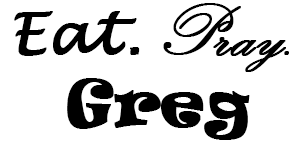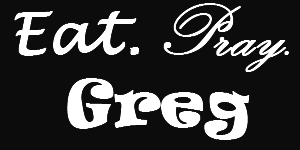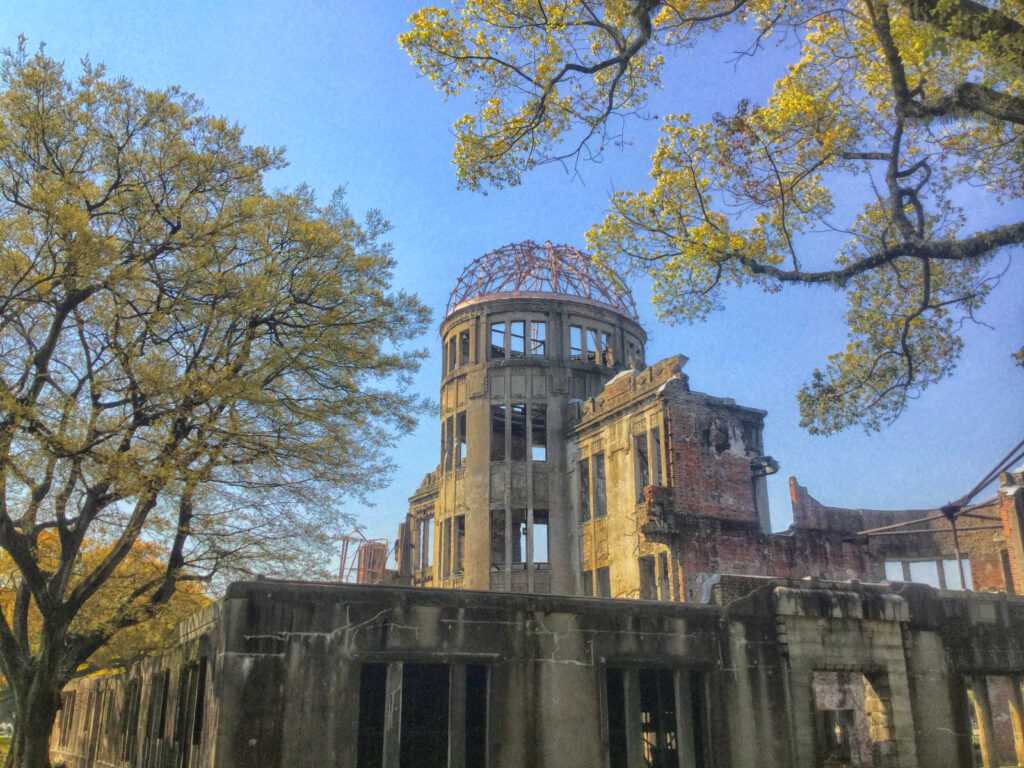I got up at 6 AM today and headed over to the bus station. I took a long look at the A-Bomb Dome before I jumped on my non-reserved bus to Hakata Station in Fukuoka. I 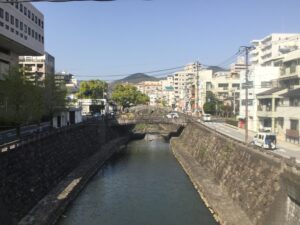 took another look as I rode out of the station. It was an uneventful trip over to Hakata, which was a good, straight shot. I then had 5 minutes to go from one bus to the next and was on my way to Nagasaki.
took another look as I rode out of the station. It was an uneventful trip over to Hakata, which was a good, straight shot. I then had 5 minutes to go from one bus to the next and was on my way to Nagasaki.
Along the way, I had some squid jerky, which was about as good as it sounds. While riding, I noticed that the Japanese had a fascinating way of eating things out of bags like chips, squid jerky, and even candy; they used chopsticks. Always hating the mess on my fingers after doing it the good old American way, I adopted this custom.
I arrived in Nagasaki, then took the tram from their bus station over to my pod hotel. 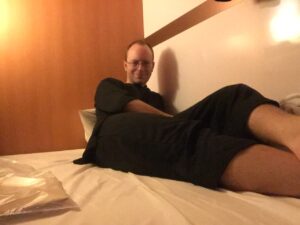 To say that this was one of the best places I had resided on my journey would be an understatement. When I arrived, as a welcome gift, they gave me a microfiber cloth monogrammed with the hotel’s insignia. I was shown to my pod (on my gender-specific floor,) which was a full bed behind a drawn shade. Within my pod were A/C controls, a safe, and a flat-screen TV. Also included in this place were free toiletries, my own, personal pajamas, and kimono. They even offered the use of their Japanese bath.
To say that this was one of the best places I had resided on my journey would be an understatement. When I arrived, as a welcome gift, they gave me a microfiber cloth monogrammed with the hotel’s insignia. I was shown to my pod (on my gender-specific floor,) which was a full bed behind a drawn shade. Within my pod were A/C controls, a safe, and a flat-screen TV. Also included in this place were free toiletries, my own, personal pajamas, and kimono. They even offered the use of their Japanese bath.
After I secured my things, I walked around Nagasaki a little. I saw some temples at the end of my street as well as some expansive Shinto cemeteries. There was a mall that had some sort of parade featuring an inflatable pink elephant for reasons unknown.
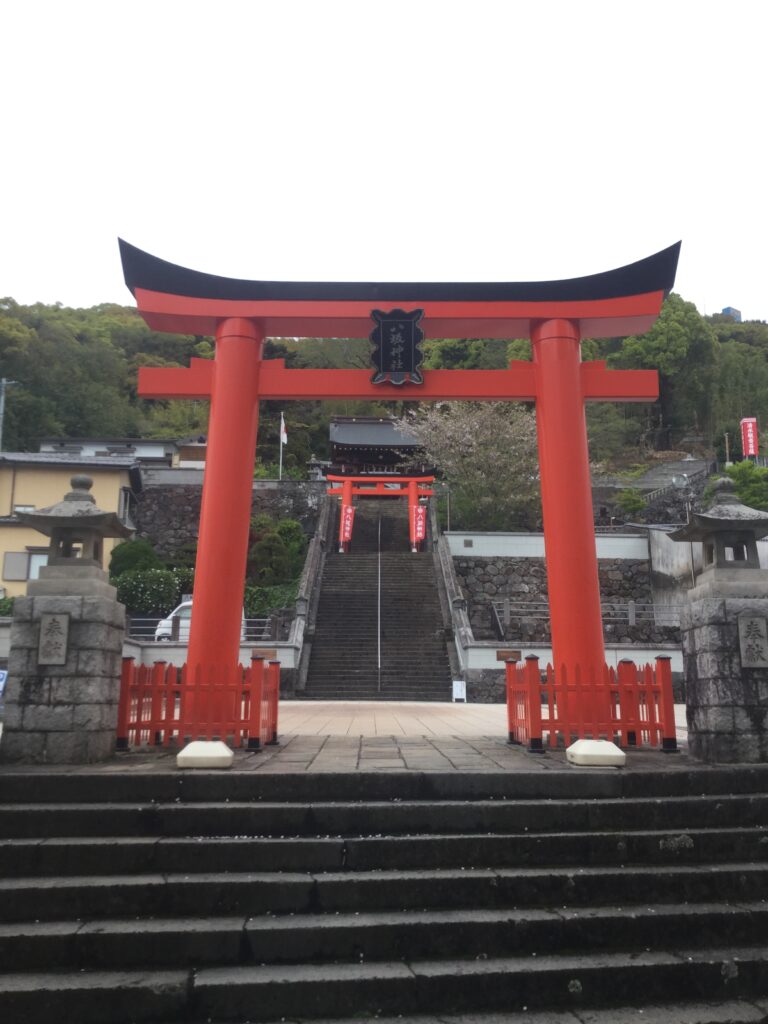
I came back to the hostel, took a bath, and shaved for the first time since Adelaide. The razors were not the best, and I ended up cutting myself more than actually shaving. I guess due to the copious amounts of walking I have done, with five miles a day on average; it looked like something is going on with my right toe. I hiked a lot when I was younger, so I knew it was probably an ingrown toenail or something. My father recommended I get a pedicure.
My evening was rather quiet. I got a little dinner, a highball, and started watching Fat Man and Little Boy as I planned my activities in the city. I then climbed in my pod, put in my earplugs, and that was that.
The next day I woke up at 6 AM for some reason. Since I had a good internet connection, I used Google Voice to call my client that was having tax troubles. He seemed in good spirits, considering. I then spent 20 minutes on hold with AT&T getting passed around like a bottle at a frat party. The international time difference can be really interesting. I just got up, and it was the end of the workday over in the US. I hung up and decided to do it later. I put on my clothes for the day, sad to get out of my jammies. I then headed to the Nagasaki Bomb Museum via tram.
On my way, something incredibly strange and uniquely Japanese occurred. As we were all riding the tram, it was shift change. The driver, dressed in an impeccable and creaseless uniform, pulled in to the stop. He then stood up, turned around, addressed us all, took a bow, then got off the tram. Then a new driver got on, addressed the passengers, bowed to us, turned around, then started driving. Having taken the streetcar many, many times in New Orleans, one can understand that this display of deference is almost entirely unheard of in the United States. I think it was in the film The Last Samurai where a Westerner who came to Japan in the late 19th Century posits that the Japanese dedicate themselves to the perfection of everyday tasks. This driver felt honored to perform his service for us, his paying customers, and would strive to do it to the best of his ability. He would do this for the company, for himself, and for his family; those still contained in this earthly realm and those already in the Great Beyond. In retrospect, it became pretty apparent why the Japanese were seemingly relentless ferocity during the war. In modern times, this devotion is echoed by the salaryman. These men would not stop until they gave every ounce of their lives and even their deaths to the ideal of honor.
What makes Nagasaki famous is the fact that it was the second city in history to be leveled by an atomic bomb. Kokura, Japan was the initial target, but cloud cover and drifting smoke from a different bombing mission over Yahata forced the mission to use the alternate target.
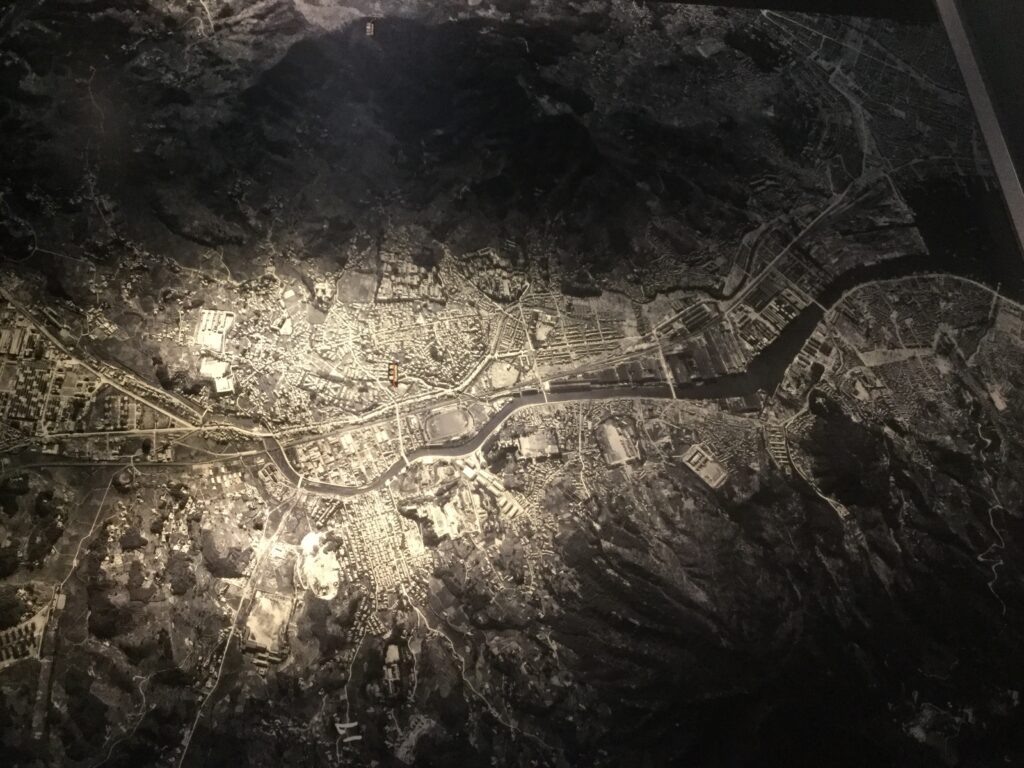
The bomb that was dropped on Nagasaki at 11:02 AM on August 9th, 1945 was code-named Fat Man. It differed from the bomb dropped on Hiroshima, Little Boy, in a variety of ways. First, the fuel for the bomb was Plutonium rather than Uranium. Second, instead of a gun mechanism, it used a spherical charge of high explosive to create uniform compression on the core. Imagine a fist wrapped around an orange and squeezing it. The detonation pushed two hollow sphere halves of the core to the point of crushing a “pit” trigger. This action then caused a chain reaction of fission in the now incredibly dense Plutonium core. This “efficient” design lead to a higher blast yield as 1 kg of material underwent fission, releasing over 21 kilotons (21,000 tons of TNT) of energy. Little Boy only released 15 kilotons. Fat Man’s mechanism was also the same type of “Gadget” tested in Los Alamos, New Mexico, before the design was sent to the South Pacific for its eventual and eventful mission.
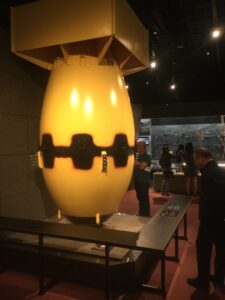 I eventually arrived at the Nagasaki Bomb Museum.
I eventually arrived at the Nagasaki Bomb Museum. 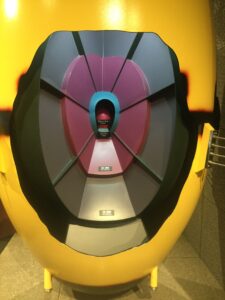 Given my experience in Hiroshima, it was about what I expected. They had a scale replica of Fat Man, including its core design. The bomb was yellow, with black stripes, something I had not known. The reason for its color was to maintain the secrecy of the bomb’s payload as many other “pumpkin” bombs with just high explosives were used on conventional targets. The black stripes were asphalt being sprayed on the bolts of the bomb to seal it.
Given my experience in Hiroshima, it was about what I expected. They had a scale replica of Fat Man, including its core design. The bomb was yellow, with black stripes, something I had not known. The reason for its color was to maintain the secrecy of the bomb’s payload as many other “pumpkin” bombs with just high explosives were used on conventional targets. The black stripes were asphalt being sprayed on the bolts of the bomb to seal it.
The museum was a little better about addressing the history of the Japanese war machine. They said that the Kwantung Army, charged with safeguarding Japanese interests in Manchuria (using the name of Japanese colony Manchukuo,) was not being directly controlled by the government back home. This statement offered plausible deniability to the current government for the Rape of Nanking. They did mention Unit 731, but in passing and also comfort women. They made sure to mention fascist actions against the populace. The acts included the expulsion of intellectuals not in lockstep with government policy, as well as the media being strictly controlled. The proposed that the people did not have an accurate picture of what was going on during the war. Ironically, all this information was on a few video monitors. Behind a wall. By the display for outlawing nuclear weapons. Close to the exit of the museum.
 One piece in the museum stopped me and took me out of my analytical mind, much like the tricycle in Hiroshima. It was a photograph of a boy with another on his back in a sort of papoose. The story goes that they were brothers, and he was walking when a photographer snapped the picture. The photographer watched as this boy took his little brother, who appeared to be sleeping, out of the papoose. He then called some workers over. They looked at the sleeping boy, then his brother. They then took the sleeping boy by the arms and legs and gently lowered him onto a pyre. The boy was dead. His brother had walked from his home with his corpse on his back to have him cremated.
One piece in the museum stopped me and took me out of my analytical mind, much like the tricycle in Hiroshima. It was a photograph of a boy with another on his back in a sort of papoose. The story goes that they were brothers, and he was walking when a photographer snapped the picture. The photographer watched as this boy took his little brother, who appeared to be sleeping, out of the papoose. He then called some workers over. They looked at the sleeping boy, then his brother. They then took the sleeping boy by the arms and legs and gently lowered him onto a pyre. The boy was dead. His brother had walked from his home with his corpse on his back to have him cremated.
Leaving the museum with a heaviness in my heart, I headed to the Peace Park. This is an area in Nagasaki that commemorates its place as being the second city in the world destroyed by a nuclear bomb. There were many statues and plaques given to Nagasaki by countries from around the world in solidarity against the use of such weapons. The one they chose to represent themselves was a giant blue man, like a classical Greek figure, sitting on his legs, pointing with one hand towards the sky.
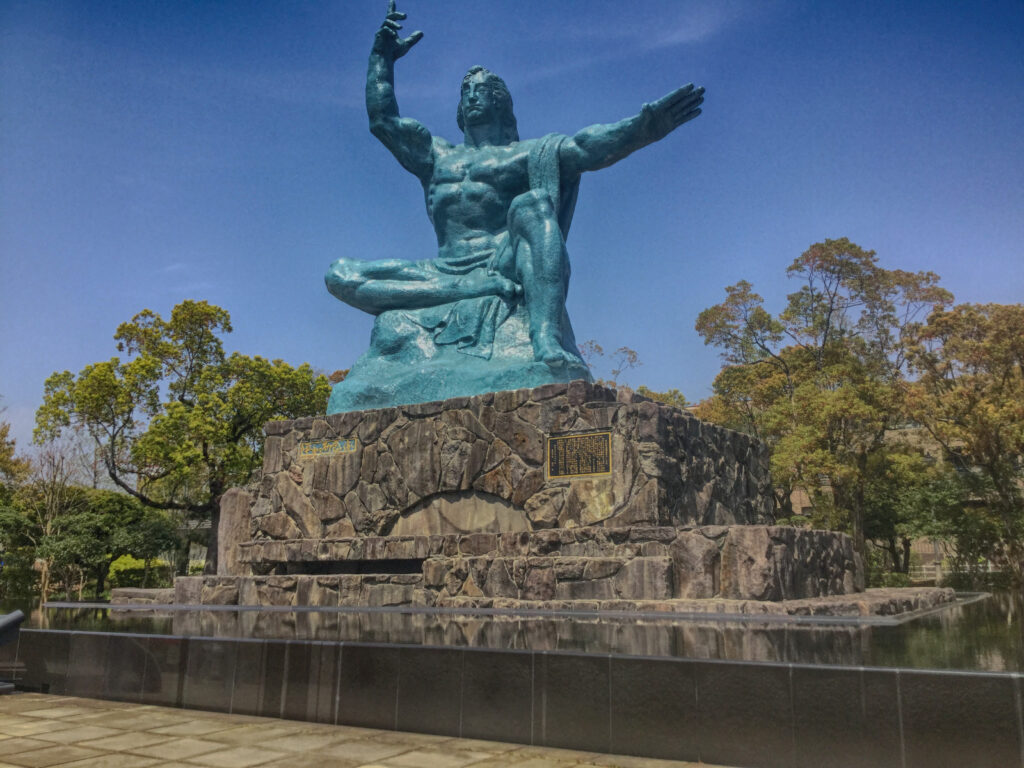
Another part of the Peace Park were various monuments with flowers and pools of water. Passersby would leave water bottles on them as an offering. When I got closer, a poster explained their purpose. Due to the intense heat of the blast, a lot of the water around the city evaporated. People would cry out for it to put out fires and soothe burns, but none was available. People were leaving water for those that could not have it at the time.
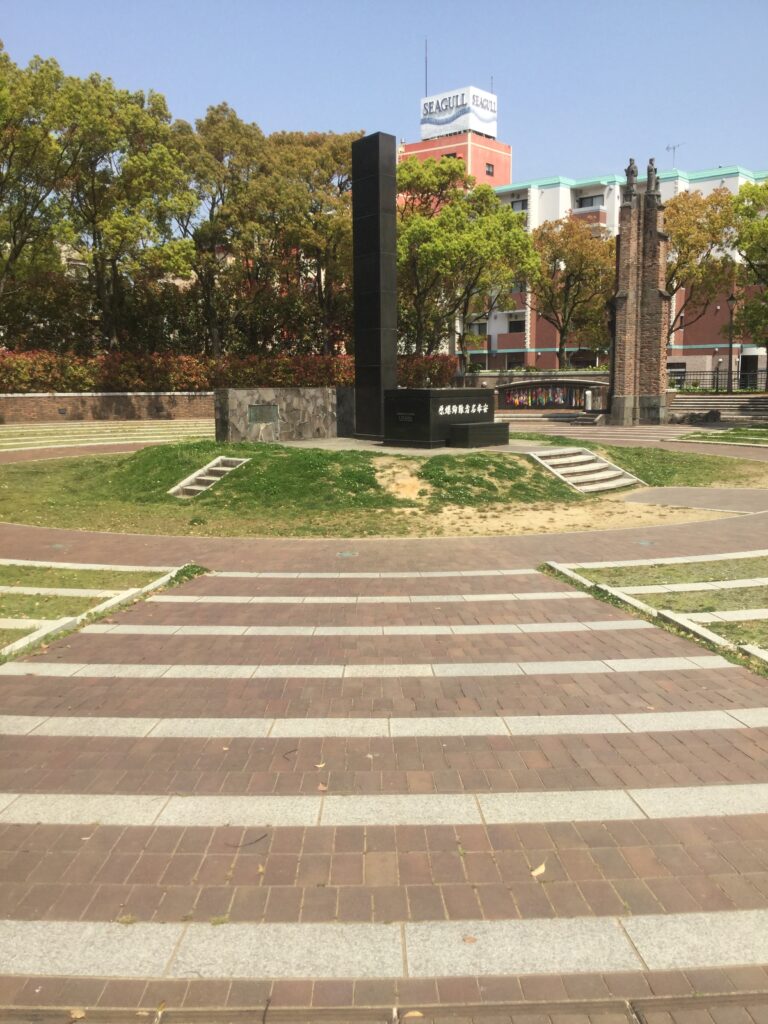
I then walked to the Hypocenter Park, directly next to the Peace Park. It was precisely above this place, at 500m, the bomb detonated. The stone pillar in the middle had rings circling it, which could mean that both this place was the central target, and also, the ramifications of using the bomb would radiate out to the rest of the world. Within this area, there were ruins of the original Urakami Church, a memorial to the slain mothers and children of the city, as well as an excavated section that showed the level of the land directly after the bombing several meters down.

From this point, I decided to get some exercise and take a hike up Mount Inasa. For maximum effect and to contain possible fallout, Nagasaki was chosen as a target due to the fact it is within a U shaped circle of mountain ranges heading out to sea. Mount Inasa was 333m up, while the bomb detonated at 500m. I hiked for a better part of an hour and a half, clearing my head and using my wits to find the lookout point as there was no clear signage. I was hurting, tired, and sweaty, but it was well worth my efforts. With a sweeping view of Nagasaki, I found the Peace Park from my vantage point and the Hypocenter. Looking out across the expanse of the city, I was in awe of the destruction the bomb did.
After a full day, I walked down the mountain, caught the tram to Chinatown, got a snack of my beloved Bao, took a Japanese bath back at the hotel, finished Fat Man and Little Boy, then got some din of instant noodles. I then tried recalling ATT and was finally able to get things straightened out.
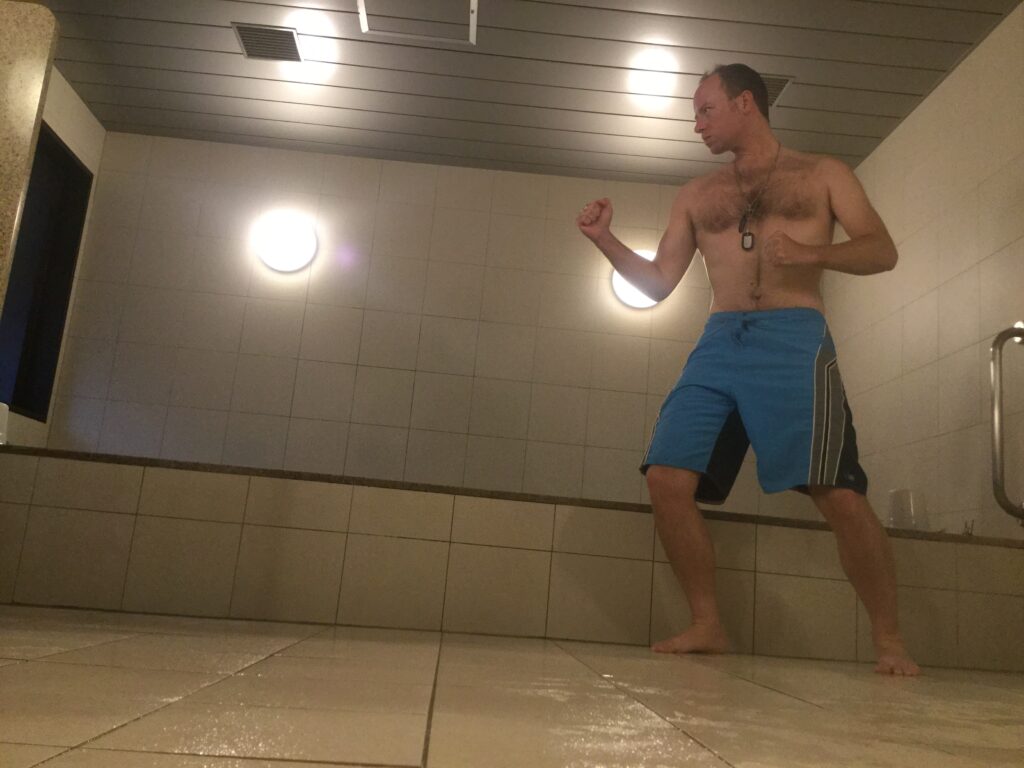
The next day I got up and set out to find a place to get a pedicure. It was difficult because nothing opened before 10 AM. I then used my nifty Google translate app to buy an all-day tram ticket. I headed out to the far reaches of the 1 line, then switched and came back to look at Oura Cathedral.
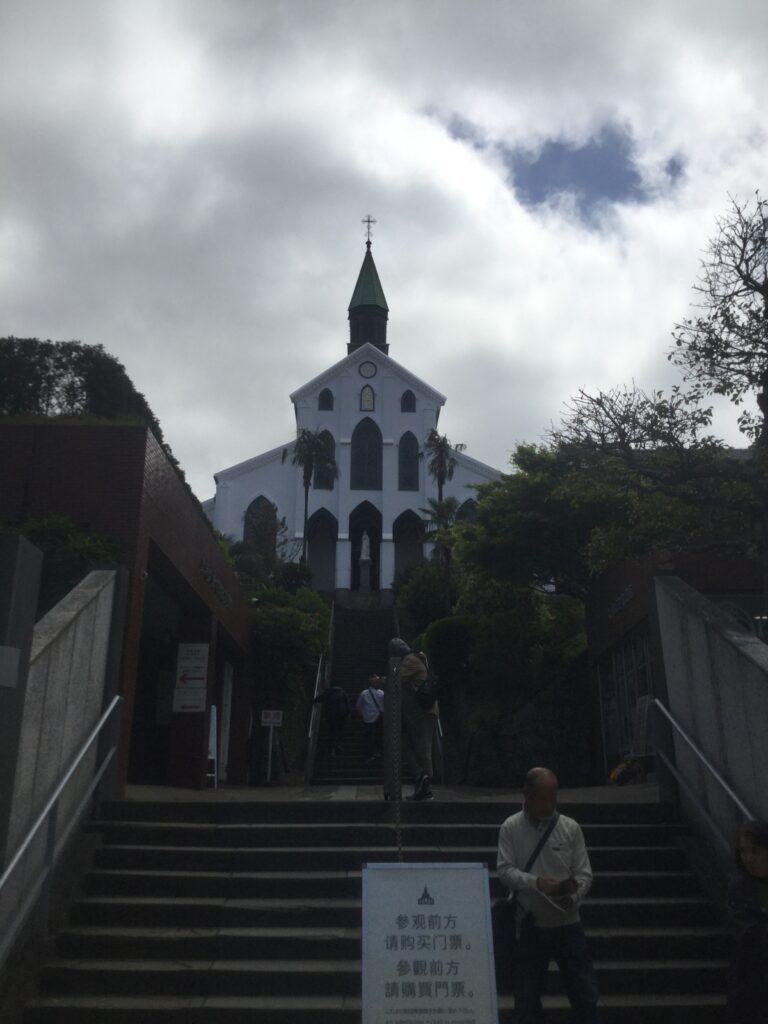
The Oura Cathedral is a Roman Catholic Church built after the government ended its Seclusion Policy in 1853. It is said to be the oldest church in the country and also the only Western design to be designated a national treasure in Japan. They wanted ¥1000, about $10, just to walk around. No, thank you. I marveled at the structure from the outside.
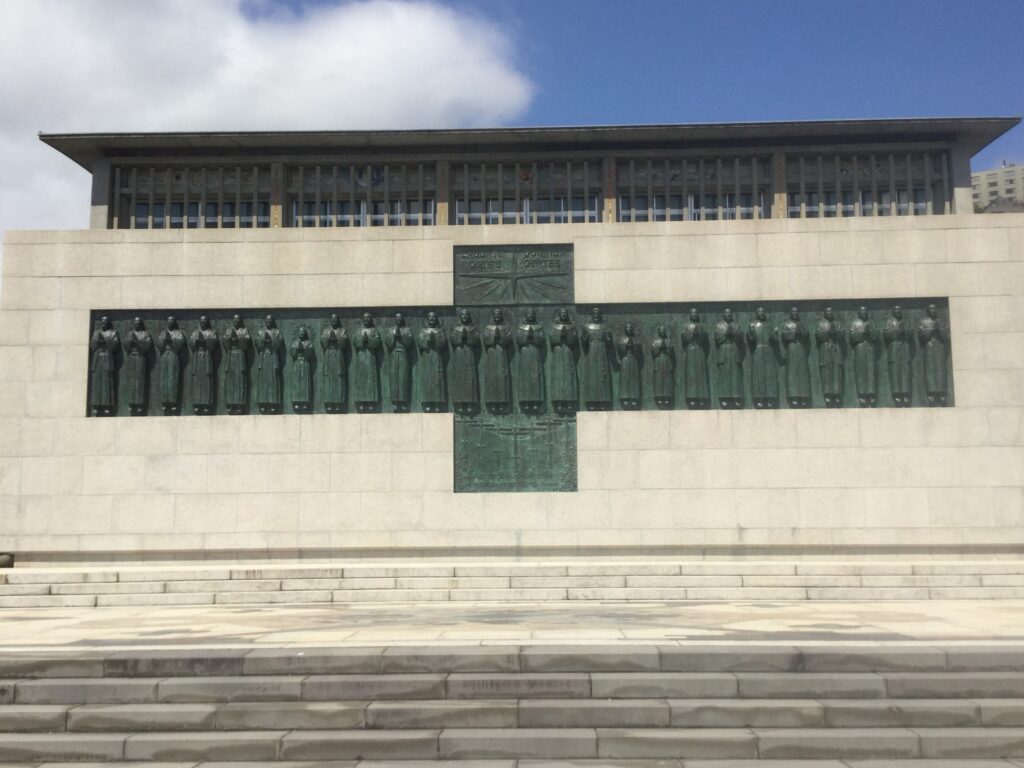
I then headed to the Memorial for the 26 Martyrs, which this cathedral for which it is also named. This was a hill in Nagasaki where the powers that be did not appreciate the proselytizing of Christianity. They demonstrated their displeasure with the crucifixion of 26 Jesuits on this hill in 1597. Obviously, this was during a less formal Seclusion Policy.
From this vantage point, peeking behind a skyscraper, I saw a silver figure. It was huge. Like, Godzilla huge. Keeping it in my line of sight as I walked down the hill, I kept walking until I found some stairs leading up to where I thought this massive figure was. Clearing my way around a few more buildings, I found myself face to face with a giant silver turtle. Riding on the turtle’s back was Buddha. This was the Fukusai-ji Zen Temple. It was built in 1628 but was destroyed by the bomb in 1945. It was subsequently rebuilt and is now the final resting place of over 16,000 war dead.
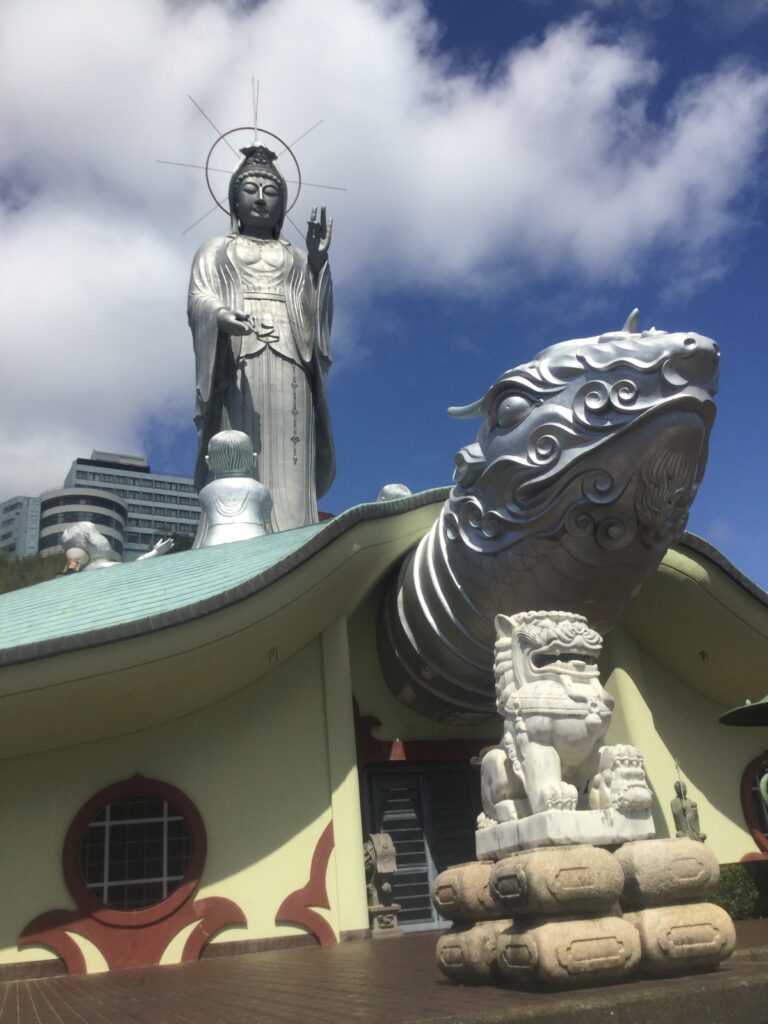
Due to this eventful morning of climbing the hills and mountain of Nagasaki, I headed back to the hotel for some rest. I did a little surgery on my toe that I hope works, seeing how all the nailticians were either booked or did not accept cash. Adequately rested, I headed back out to see the rest of what Nagasaki had to offer.
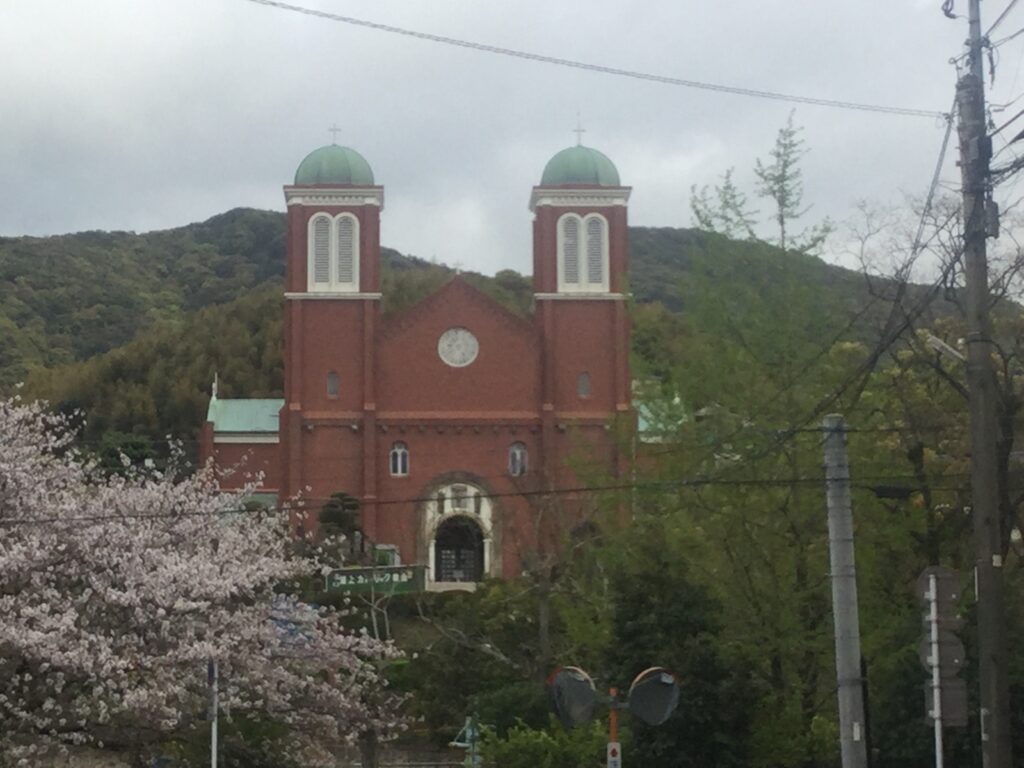
The Urakami Church or Immaculate Conception Cathedral was built in 1925 but destroyed 20 years later. Its ruins were within the irradiated rings of the hypocenter mentioned earlier. It was then rebuilt after the war. I walked into the church and sat down for a bit in a pew. Upon entering, I was amazed at how the tranquility of this place washed over me. It was incredibly peaceful inside with a dim, yet calming blue light wrapping everything, including myself, in divine serenity. I sat and thought about everything I had seen so far on my adventure and everything I would see.
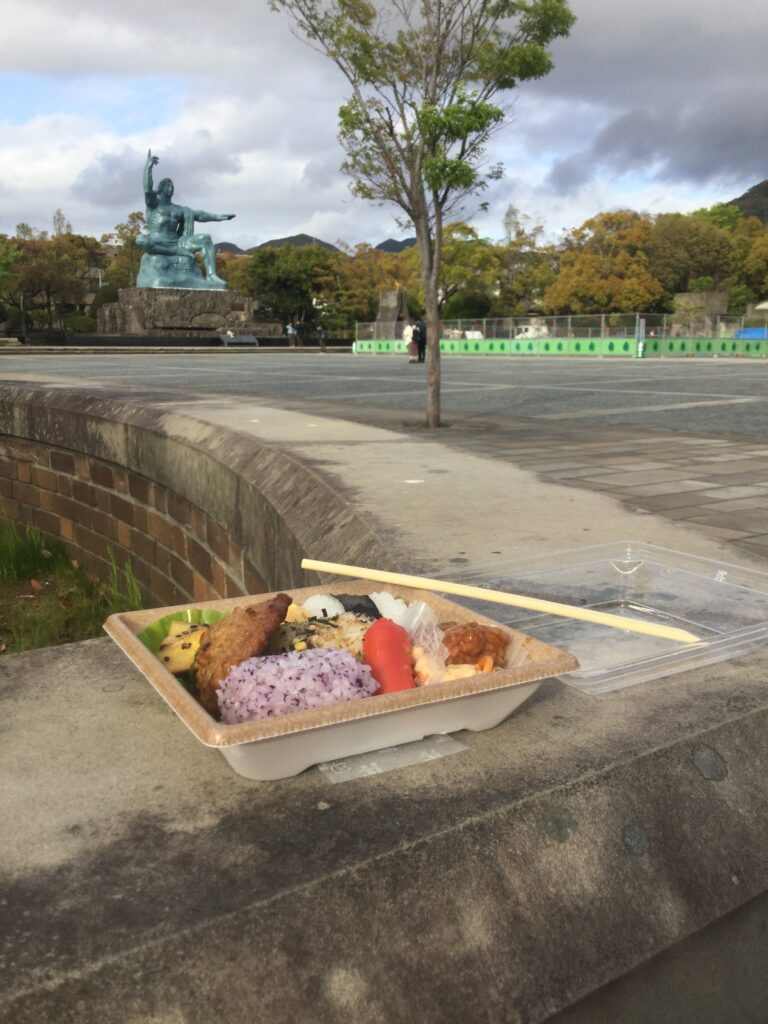
I then went and got dinner, a lovely sushi plate, and ate in the Peace Park with my new blue friend. As I was walking to the tram, I looked down and saw a purple and red woven bracelet like children used to make a summer camp. I looked around for the owner, but no one was around. I realized that this might be a gift from the city of Nagasaki for coming to visit. I walked back through the Hypocenter Park, then went back to my hotel to enjoy the Japanese bath for the final time. I filled my stomach with a bowl of noodles as my sushi dinner did not entirely cover my hunger for the day. While in the store, I also got some supplies for the road. I tucked into my pod room for my last night in Nagasaki. Fukuoka tomorrow!
